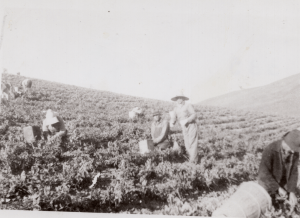Land Acknowledgement
The Pajaro Valley is the unceded territory of the Mutsun-speaking Calendaruc Tribe. The Amah Mutsun Tribal Band, comprised of the descendants of indigenous people taken to missions Santa Cruz and San Juan Bautista during Spanish colonization of the Central Coast, is today working hard to restore traditional stewardship practices on these lands and heal from historical trauma. All people are asked to support these efforts. For more information about the Amah Mutsun Tribe follow the link here (amahmutsun.org), and for more information about their stewardship work by way of the Amah Mutsun Land Trust follow the link here (amahmutsunlandtrust.org).
Filipino American Migration
The Pajaro Valley has functioned as the agricultural driver of Santa Cruz County since the nineteenth century. Today,

it is the fifth most agriculturally productive region in the state. Filipino migrant laborers in particular mostly came to the region at the beginning of the twentieth century, when over 100,000 were recruited from the Philippines to toil in U.S. fields and canneries. Known as the manong (Ilokano/Tagalog: older brother) generation of migrant workers, thousands of primarily young and single Filipino men traveled to the central coast of California to develop its landscape. In Santa Cruz County, they were recruited into low-wage farm jobs. Their employment entailed picking and sorting crops such as lettuce, cucumbers, beans, and strawberries; hauling irrigation pipes; and tilling acres of land. They often worked eleven-hour days, six days a week, with very little compensation. These workers traveled along California’s central coast and the wider U.S. Pacific seaboard, following seasonal crops in search of employment opportunities.
At the time Filipino Americans faced many exclusionary and racist policies that attempted to prohibit Filipino Americans from raising families in California. Women and children were barred from making the journey from the Philippines because labor recruiters favored single men, and anti-miscegenation laws made it largely illegal for Filipino men to marry white women. In addition, manong faced constant threats of racial violence. For example, in January 1930, over 700 young white men terrorized the town of Watsonville, fueled by racist rhetoric and anti-miscegenation cries. The mobs targeted Filipino migrant laborers, and five successive days of looting, indiscriminate violence, and arson apexed in the murder of twenty-two-year-old Fermin Tobera, who was killed in his sleep when rioters stormed his labor camp.

Despite these exclusionary laws and racist acts, manong in the Pajaro Valley created a sense of home and built families. Many manong joined the First and Second Filipino Infantry and fought in the Philippines during World War II. They later used their GI Bill benefits to purchase land and start businesses. They also courted women in the Philippines who traveled to the U.S. after immigration laws eased following World War II. Others were involved in mixed-race relationships with white and Mexican American women despite anti-miscegenation laws. As a result, a thriving Filipino community was formed and nurtured in Watsonville and the greater Pajaro Valley. Members of the Filipino community created and participated in important community organizations including the Caballeros de Dimas-Alang, Filipino Community Organization, Filipino Women’s Club of Watsonville, Filipino Catholic Association, and Filipino Visayans. Their agricultural, civic, and family lives made a lasting impact on the vitality and complexity of Santa Cruz County and the California Bay Area.
